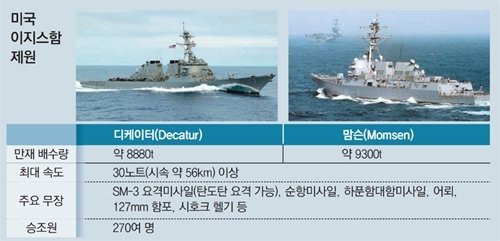2 US Aegis destroyers to conduct anti-submarine drill around Korean Peninsula
2 US Aegis destroyers to conduct anti-submarine drill around Korean Peninsula
Posted May. 19, 2016 08:00,
Updated May. 19, 2016 08:13

According to sources in the U.S. Forces Korea, U.S. Navy Aegis destroyers USS Decatur (DDG 73, 8,880 tons) and USS Momsen (DDG 92, 9,300 tons) will conduct an anti-warship and anti-submarine drill with the South Korean Navy’s destroyers and anti-submarine helicopters in the South Sea and the Yellow Sea from Thursday.
The Aegis destroyers from the US Navy’s Western Pacific prepositioning fleet are equipped with torpedoes, battleship guns, and the SM-3 missile that can intercept the North’s various ballistic missiles, as well as with cruise missiles that can launch precision attacks at enemy targets thousands of kilometers away.
Notably, the USS Decatur drew attention back in 2013 for pilot launch of the THAAD system that successfully intercepted the North’s intermediate range missile, hypothetically the Musudan, in waters off the Marshall Islands in the Western Pacific.
In the upcoming drill, the South Korean and U.S. Navies will also reportedly conduct exercise to detect the North’s surprise launch of short-range ballistic missiles (SLBM). “The upcoming drill is purely defensive in nature," a source in the U.S. Forces Korea said. "It is aimed at enhancing joint operation capacities of the South Korean and U.S. Navies, and at defending the Korean Peninsula and maintaining stability in the region.”
To counter the North’s ballistic missiles, Aegis destroyers from South Korea, the U.S. and Japan will carry out a drill of alert for the first time in waters near Hawaii in late June. In the drill, the U.S. will fly aircraft hypothetically assumed as North Korean missile, and the destroyers will detect and trace the missile to identify its trajectory, and share related data.







